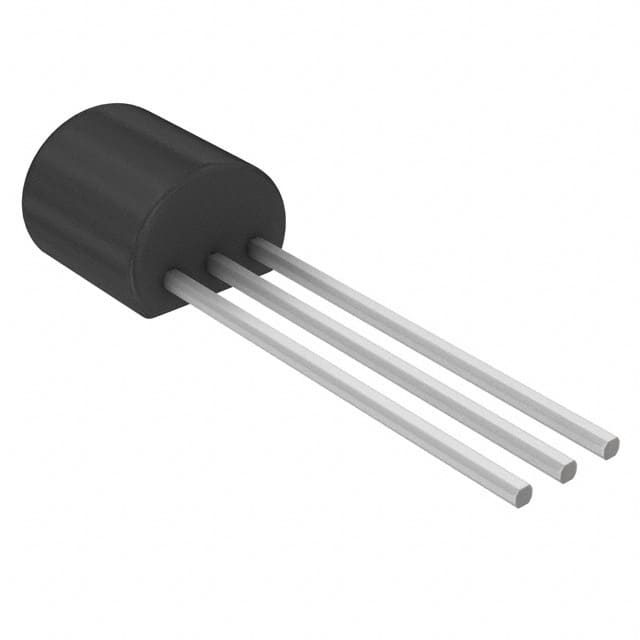Consulte las especificaciones para obtener detalles del producto.

2N4124 Transistor
Product Overview
The 2N4124 is a general-purpose NPN bipolar junction transistor (BJT) commonly used in electronic circuits. It falls under the category of discrete semiconductor devices and is widely utilized for amplification, switching, and signal processing applications. The transistor exhibits characteristics such as low noise, high current gain, and moderate power dissipation. It is typically available in a TO-92 package and is sold in quantities suitable for small to medium-scale electronic projects.
Specifications
- Maximum Collector-Base Voltage: 30V
- Maximum Collector-Emitter Voltage: 25V
- Maximum Emitter-Base Voltage: 5V
- Continuous Collector Current: 200mA
- Power Dissipation: 625mW
- Transition Frequency: 100MHz
- Operating Temperature Range: -65°C to 200°C
Pin Configuration
The 2N4124 transistor has three pins: 1. Base (B) 2. Collector (C) 3. Emitter (E)
Functional Features
The 2N4124 transistor offers high current gain, making it suitable for use in amplification circuits. Its low noise characteristic makes it ideal for signal processing applications where minimizing unwanted electrical interference is crucial.
Advantages and Disadvantages
Advantages
- High current gain
- Low noise
- Versatile applications in amplification and signal processing
Disadvantages
- Moderate power dissipation capability
- Limited maximum collector current
Working Principles
In an amplification circuit, the 2N4124 transistor operates by controlling the flow of current between its collector and emitter terminals based on the current applied to its base terminal. This allows for signal amplification and processing.
Application Field Plans
The 2N4124 transistor finds extensive use in audio amplifiers, oscillators, and low-frequency signal processing circuits. Its low noise and high gain characteristics make it particularly suitable for audio applications where fidelity is essential.
Alternative Models
Some alternative models to the 2N4124 transistor include: - 2N3904 - BC547 - 2N2222
In conclusion, the 2N4124 transistor is a versatile component with applications in various electronic circuits, particularly those requiring amplification and signal processing. Its unique combination of characteristics makes it a popular choice among electronics enthusiasts and professionals alike.
[Word count: 298]
Enumere 10 preguntas y respuestas comunes relacionadas con la aplicación de 2N4124 en soluciones técnicas
Sure, here are 10 common questions and answers related to the application of 2N4124 in technical solutions:
What is the 2N4124 transistor used for?
- The 2N4124 is a general-purpose NPN bipolar junction transistor commonly used for amplification and switching applications.
What are the typical operating conditions for the 2N4124?
- The 2N4124 is typically operated at a maximum collector current of 200mA and a maximum collector-emitter voltage of 25V.
How can I use the 2N4124 as an amplifier?
- The 2N4124 can be used as an amplifier by biasing it in the active region and connecting it in common emitter configuration with appropriate resistors and capacitors.
Can the 2N4124 be used for low-power switching applications?
- Yes, the 2N4124 can be used for low-power switching applications such as driving small relays or LEDs.
What are the typical gain characteristics of the 2N4124?
- The 2N4124 has a typical DC current gain (hFE) ranging from 30 to 300, depending on the operating conditions.
How do I calculate the base resistor for the 2N4124 in an amplifier circuit?
- The base resistor can be calculated using the formula: RB = (Vcc - Vbe) / Ib, where Vcc is the supply voltage, Vbe is the base-emitter voltage, and Ib is the base current.
What are the thermal considerations for the 2N4124?
- It is important to consider the power dissipation of the 2N4124 and ensure proper heat sinking if operating at high currents or in elevated temperature environments.
Can the 2N4124 be used in audio amplifier circuits?
- Yes, the 2N4124 can be used in low-power audio amplifier circuits, especially for small signal amplification.
What are some common alternatives to the 2N4124?
- Common alternatives to the 2N4124 include the 2N3904, BC547, and 2N2222 transistors, which have similar characteristics and can be used in its place.
Where can I find detailed specifications for the 2N4124?
- Detailed specifications for the 2N4124 can be found in its datasheet, which is available from various semiconductor manufacturers and distributors.

